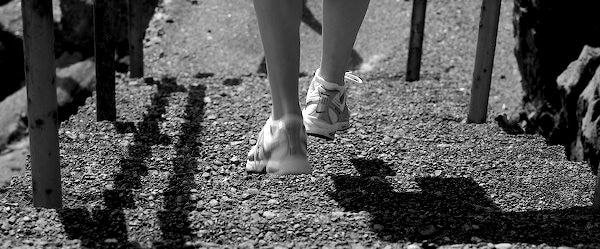|
I still remember my very first pair of running shoes. I must have been 1979 and I would have been 12. My dad took me to Athlete’s Foot in Halifax and I got a brand new pair of their own branded shoes: blue and red suede uppers, a white foam midsole that had blue and red stripes in it, and a wavy gum rubber outsole. I went for a test run on the sidewalk outside the shop and felt I was running on pillows. I was so excited! I felt as springy as a Gazelle after my flat canvas low tops. I ran in a matching outfit of white cotton rugby shorts with blue and red piping, and a red and blue striped rugby shirt.
Back in the 1960’s, the post war baby boomer generation had already changed the way footwear was being worn. The conservative, tight pre war era of leather dress shoes had given way to a looser more relaxed dress code and my friends and I bombed about the neighbourhood in Keds, and Dash boots and other canvas sneakers, which our British born parents called Plimsolls. Most of us didn’t yet run in specialized footwear for running but wore the same flat, canvas sneakers for everything: running, sailing, basketball, volleyball and soccer. If I wasn’t in my canvas shoes, I was probably in sock feet. Nobody talked about cushioning, support, responsiveness or pronation. You put on your sneakers and ran. Specialized running shoes were still the domain of professional sports teams, sponsored athletes and the Olympics. As the running boom boomed, sneakers became technical running shoes, and cushioning became the Holy Grail, probably maxing out in the mid 90’s with the eponymous Nike Air Max -that brick of a shoe with the transparent air bag in the sole. Moving forward two decades, if I look at my contemporary footwear over the last 5 years it has a strikingly similar quality to those early shoes I wore at 10, not the overly cushioned clunkers I wore as a teenager. I now wear a flexible neutral shoe, that has a basic 6 mm drop from heel to toe. They work for me. What has changed—and this is the product of 40 years of shoe research and technology—is that my shoes now have a comfortable molded foot bed and insole, and a high tech rubber midsole that offers incredibly lightweight but effective shock absorption. My NB Zante training flats, are, incidentally, lighter than any racing flat I wore in the 80’s and 90’s! Between the early days of plimsolls, sneakers and runners to the minimalist, barefoot movement, then the maximalist oversized outsole cushioning trend, the high technology training shoes of today sums up a fascinating snapshot of the birth of the running shoe and the ‘fitness movement’ of which marathon running, amateur cycling, ultra, and triathlon and are all a part. This history of the running shoe is actually a story that has always been a combination of fashion, social change, marketing, economics, and science. The first real running shoes were probably made in the late 1800’s and they were custom leather shoes fitted with spikes for better grip. When the modern Olympics started, running was still an activity for the elite and affluent. The large working class had little time to train nor the privilege of traveling by steamship to the few competitions that were out there. By 1910, vulcanization allowed for the manufacture of a soft flexible shoe that had the rubber sole attached to the upper, creating a quiet shoe that became known as the ‘sneaker. By the 50’s, Keds, PF Flyers, Converse All Stars and their copycats were flooding the post war market in the US and Canada. In a fun connection, cyclists and triathletes will be happy to know that the first sneakers—the shoes with rubber attached to their soles—were first manufactured in smaller rubber companies that specialized in the production of bicycle tires. In 1967, two coaches called Bill Bowerman and Phil Knight were shaking on a business deal to import runners into the US market from Japan. By the time I turned 12, they had already started marketing the first Nike Waffle Racers. Anyone who ran in the late 70’s will remember this classic: royal blue with a yellow swoosh and a trademark black waffle sole. Once specialized runners caught on, shoe companies were onto the new movement, hiring podiatrists and designers and marketing gurus to design and sell shoes to a new market where sports footwear was as fashionable as it was necessary for performance. Looking back it is easy to see that all kinds of gimmicks, gadgets and dubious design features were introduced in order to gain an edge in a competitive and fickle market. (Think visible air bags, springs and other shock absorption devices, flashing lights, the Energy Return System...). While the most current debate in the running shoe industry focuses on whether barefoot running is actually superior to the shod foot surrounded by support and cushioning, one thing is clear: shoe technology is more advanced right now than it has ever been, and it is big bucks. My kids are wearing pricey iconic remakes of the Adidas, Nikes, Reeboks and Pumas of the 80’s, however I still have a soft spot for the unchanged simplicity of the flat canvas Converse all Star. I have been training in running shoes for over 30 years, and the shoes on the market today are superior in every way to that first pair of suede runners I owned. There are some things that can’t be improved however. No company has yet come up with comfort and fit system better than a simple set of shoe laces. Lucy Smith January 31, 2018
0 Comments
Your comment will be posted after it is approved.
Leave a Reply. |
joyWriting about the art of moving well and the lived experience of a life in sport. Archives
March 2023
Categories
All
|

 RSS Feed
RSS Feed